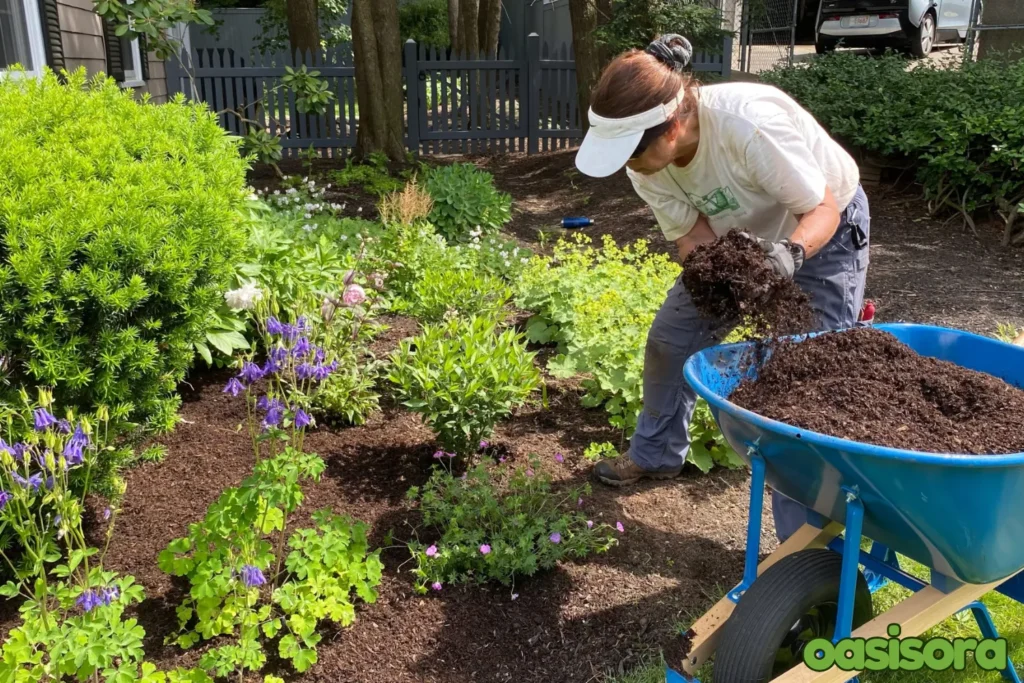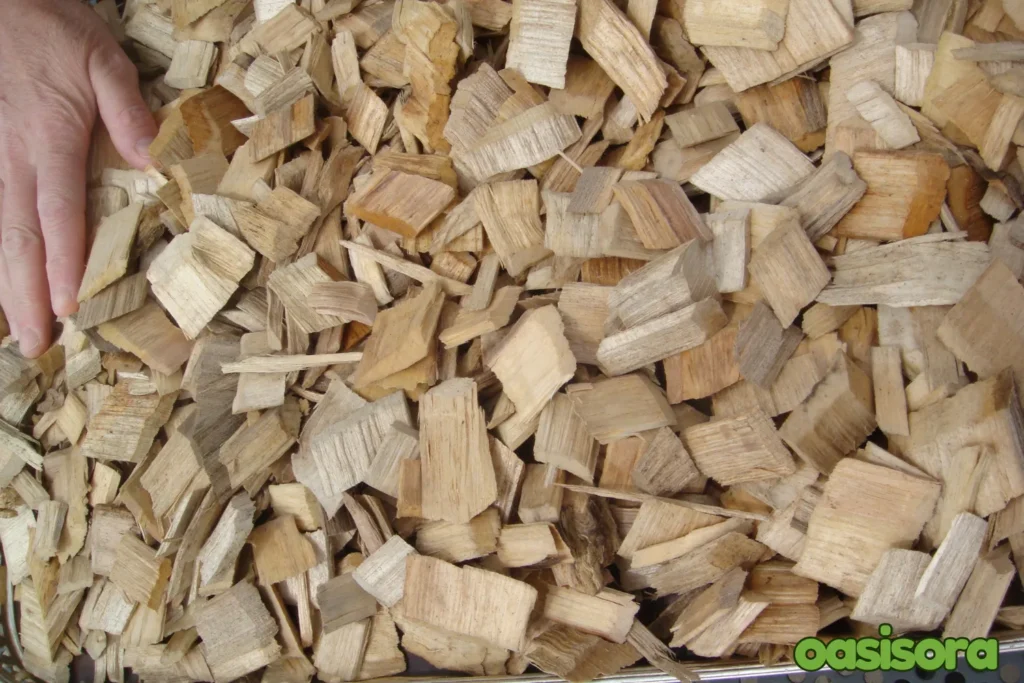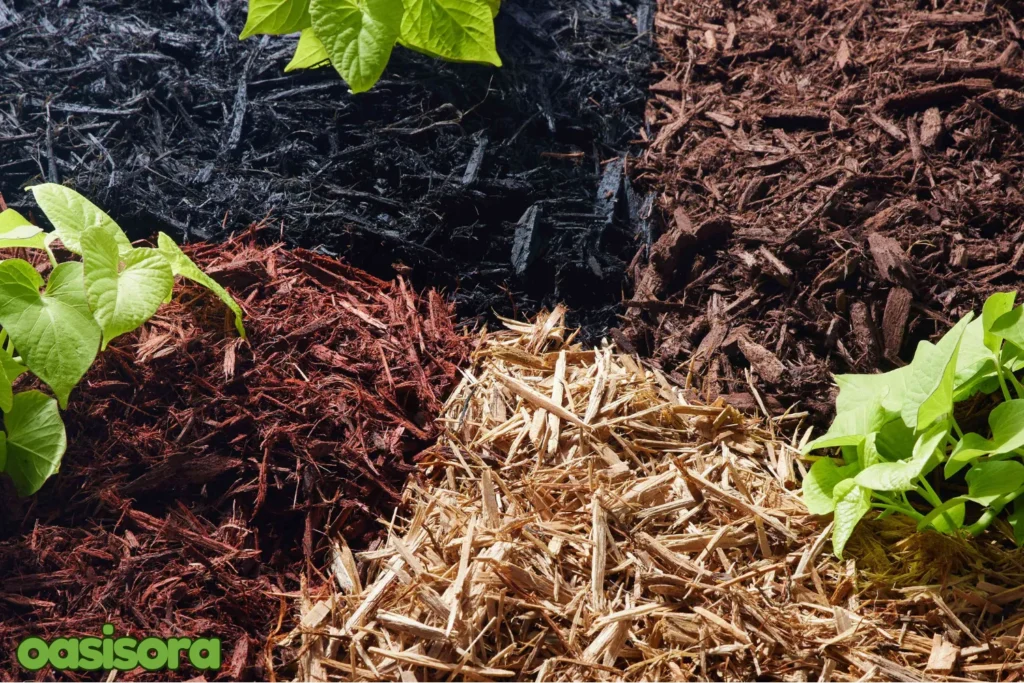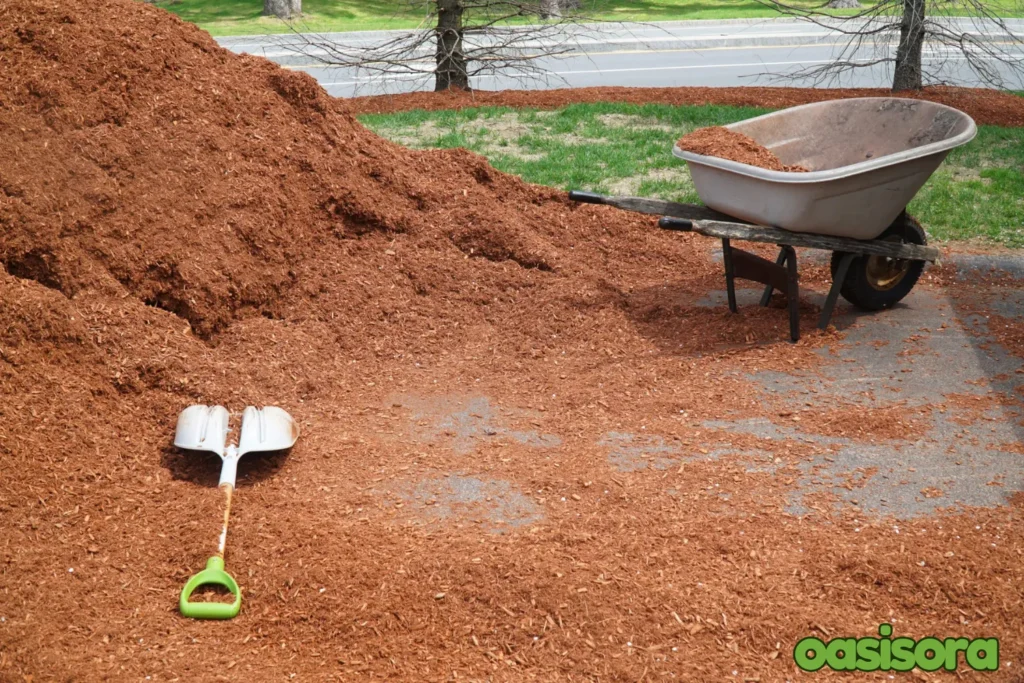
Bark dust is a versatile and eco-friendly landscaping material that not only enhances the visual appeal of your garden but also supports plant health. Often used as a ground cover, bark dust helps retain soil moisture, suppress weed growth, and regulate soil temperature making it ideal for both residential and commercial landscapes. Its rich, earthy texture adds a clean and polished finish to garden beds, pathways, and around trees. Whether you’re looking to improve soil quality or simply give your yard a more refined look, bark dust offers a practical and attractive solution.
In this guide, we’ll explore the top benefits of bark dust and provide expert tips on how to apply it effectively for long-lasting results.
What is Bark Dust?
Bark dust is a great yard helper!. It’s made from tiny pieces of tree bark. It protects the soil, keeps temperatures and pH levels just right, and makes your yard look amazing.
One of the simplest ways to improve or enhance the appeal of your landscape is by using bark dirt.
Benefits:
Bark dust is great for many yard needs! It’s perfect for:
- Play areas with swings and slides
- Garden beds
- High-traffic areas
- Is Cost Effective
- Easy to Apply
- Offers Finished Look
It’s soft, yet strong, making it a great choice!
Common Misconceptions:
Many people confuse the bark dirt with mulch, wood chips, or other sorts of ground coverings. However, bark dirt is different and boasts unique characteristics and perks.
There are many types of bark dust. Each one looks different because it comes from different kinds of trees.
Mulch vs. Bark Dust – What’s the Difference?

Mulch for Landscaping
Mulch and bark dirt are similar but different. Mulch is made from things like leaves, moss, and manure. It helps make the soil healthy.
Bark dirt does different things. It protects the soil from sun, rain, and wind. It also stops weeds from growing and prevents erosion.
Plus, it looks very nice!
Bark Dust VS. Wood Chips – Which one is Better?

Wood chips
Wood chips and bark dirt or dust are similar but different. Both come from trees and help gardens look lovely. They stop weeds and make outdoor spaces pretty.
But they’re made differently and have various benefits. There are two kinds of yard coverings: bark soil and wood chips. Bark soil comes from softwood trees like fir, pine, and spruce.
It is composed of both little and huge pieces. Hardwood trees, like oak and maple, are a key source of wood chips. They’re bigger and stronger than bark soil. Wood chips might not look as nice, but they’re still great for gardening!.
Selecting the Correct Material
The first thing to do is to figure out which bark dirt, mulch, or wood chips mesh with your specific landscaping requirements. If you desire a decorative protective barrier, bark dirt would generally fit the need.
When nourishing the soil is preferred, mulch is the route to go. Good for a rustic, natural look, wood chips could be another desirable option.
Other Uses of Bark Dust in Landscaping
As discussed above, Bark dust is really a versatile landscaping material made from ground tree bark. It adds a decorative hint to your yard, making it a worthy element in landscaping design.
Mulching and Soil Improvement Uses
Firstly, let’s discuss the mulching perks of this remarkable landscaping material:
- Moisture Retention
Bark filth helps in the retention of water in the dirt, thus decreasing the necessity for frequent watering, especially in hot, dry climates.
- Temperature Regulation
It can help defend plant roots from extreme temperatures by acting as an insulator. No matter whether it’s the cold winters or summers!
- Weed Suppression
A layer of bark dirt blocks sunlight, preventing weed seeds from germinating and growing.
- Soil Enrichment
As this sort of mulch breaks down, it supplements nutrients and organic matter to plant soil, making it healthier.
Decorative and Functional Uses
We will now talk about this dust’s aesthetic applications:
- Improvement of the Yard’s Beauty
You may use this dust to create a cohesive and impressive look in your gardens and landscapes by giving them a natural, rustic feel.
- Paths and Walkways
Bark soil can be used to create decorative walkways and paths, offering a soft, walkable surface.
- Flowerbed Edges
For yard boundaries and to give flowerbeds and borders a polished appearance, a layer of bark dust can be applied along their margins.
- Play Areas
This dust is sometimes used as a soft and safe surfacing material in children’s play areas.
Environmental Perks
Lastly, let’s discover the numerous environmental perks of this filth:
- Decreased Dependence on Chemical Herbicides
Chemical herbicides are not needed if you use wood dust. Because it naturally reduces weeds. So your gardening will be greener.
- Healthier Soil
Bark dirt adds organic matter, improving soil structure and helping plants grow.
- Lessen Yard’s Dust
It reduces dust and soil erosion in the wind, keeping your garden looking great.
Various Types of Bark Dust for Landscaping

Different Types of Bark dust
If you are searching for a way to make your yard look astonishing? Bark dust is a great option! Mulch and bark come in numerous colors, textures, and sorts. So, you can easily pick the best one that matches your lawn’s specific needs and design.
- Fresh Fir Bark Dust
Fresh fir dust is a popular choice for gardens. It’s gorgeously orange-red in color and medium in size. It’s good for new gardens because it’s nice to the touch. This kind of bark dust is excellent for maintaining the health of your soil and managing weeds.
- Aged Fir Bark Dust
As fir bark powder gets older, it changes color and texture. It turns a muted brown shade and becomes a bit rougher. This type of bark dust is perfect for older gardens that need a little TLC. It’s gentle and helps restore your garden’s health.
- Bright Hemlock Bark Dust
Bright hemlock bark dirt is a versatile option. It has a lovely rust-red color and is perfect for gardens with kids and pets. This type of bark dirt is also sliverless, making it safe for play areas.
- Dark Hemlock Bark Dust
Dark hemlock bark powder is another great option. It’s also sliverless and comes in a range of colors, from deep red to almost black. This type of bark dust gives your garden a modern and sophisticated look.
- Pine Bark Nuggets
Nuggets of pine bark are durable and excellent for retaining moisture while controlling weeds. You may pick the ideal size for your garden because they are available in both small and large pieces.
- Cedar Chips
Cedar chips come from cedar bark. They smell nice and last long. They’re perfect for paths and decorations. Cedar chips also keep pests away, keeping your garden safe from critters. They’re a great choice!.
Medium Fir – Where It Works Best
Medium fir bark mulch is really amazing for your yard! It keeps the soil wet, stops weeds, and makes the soil just great for plants. It looks nice too! You can use it in your garden paths and around trees. If you want an oasis that’s so easy to care for and looks super cool, then medium fir bark mulch is a great choice.
Plus, it also helps plants grow very strong and healthy. You can make your garden look aesthetically awesome with this mulch! It’s like a special helper that makes everything in the yard better. So, for anyone who loves gardening and wants to make their garden the best, it is the perfect choice.
Dark Hemlock – Popular for Residential Landscapes
Dark hemlock bark mulch is like a magic material for your outdoor oasis. It can add a richer, darker color and help the soil stay nutritious and healthy for plants. It’s great for walking paths and tree boundaries. This type of mulch keeps the soil moist, stops various weeds, and helps plants grow really resilient and strong. It’s an excellent choice for people who want a beautiful plus healthy garden. So, make use of Dark hemlock bark mulch today to make your residential garden look remarkable, and it is also easy to use, too.
How Much Bark Dust Do I Need?

Bark dust in large scale for lanscaping
Are you preparing to dust your yard or garden with bark dust? For this, you will be pondering how much bark dust I need. Of course, this is one of the most vital issues to tackle.
Don’t fret! It’s not as tricky as it seems. You can determine the exact quantity of bark soil you require with a few easy instruments and advice.
Bark Calculator
You must consider two factors to determine how much bark dust you require:
- How immense is the area you want to cover with it? Measure it and write down the size in square feet.
- How thick do you want the bark dust layer to be? Decide on the thickness and write it down in inches.
Now my folks don’t panic!.
It may seem problematic to figure out how much bark dust you’ll need, but it’s not! A Bark Calculator is an extremely useful online tool. Using the Bark Calculator is Easy!
Just follow these simple steps:
- Find a Bark Calculator online.
- Type in the size of your area (in square feet).
- Type in the thickness of the bark dust layer (in inches).
That’s it! This remarkable calculator will do the rest.
How Thick Should My Bark Dust Be?
So, how thick should your bark dirt layer be? The thickness of your bark dust layer depends on what you want. Here are some tips:
- To Stop Weeds:
Use a thick layer of 3-6 inches. This will block light and prevent weeds from growing.
- For Decoration:
Use a thinner layer of 1-2 inches. This will give you a great look without wasting bark dust.
Remember, it’s totally up to you! Just choose the right thickness to achieve your goals.
Tips for Effective Bark Dust Application
Are you ready to get the most out of your bark dust? Proper application is key! Here are some practical tips to help you maximize the benefits of bark dust:
Preparing the Soil
To help your bark dust do its best, prepare the soil first to maximize the effectiveness of your bark dust. What to do is as follows:
- Make the space clear: Clear away any old mulch, weeds, and rubbish.
- Loose the soil: You can do this by gently boring two to three inches below the soil’s surface.
- Enhance soil quality: You can add extra organic matter if the soil is heavy clay or sandy, like:
Compost or old well-rotted manure. This will help add life to it by increasing its ability to hold moisture and nutrients.
Layering Techniques
Now it’s time to apply the bark dust! Here are some best layering techniques you should remember:
- Start with a thin layer: Add about 1-2 inches of bark dust. This is the perfect amount.
- On slopes, start at the bottom: If you’re putting bark dust on a hill, start at the bottom and work your way up. This helps prevent it from washing away!
Timing Your Application
What time of day is ideal for applying bark dust? The growth cycle of your plants and your climate will determine this. Here are some simple tactics:
- If you live in a cool place, then add it in the spring or fall. The weather is nice and mild then.
- If you live in a warm place, add bark dust in the winter or early spring. It’s cooler then.
Don’t add bark dust when it’s raining a lot or super hot outside. It’s not good for the bark dust or your plants!
Avoiding Common Mistakes
Here are some common mistakes to avoid when applying bark dust:
- Over-application:
Don’t put too much! It can hurt plants and stop water from getting to the soil.
- Poor drainage:
Make sure the water drains well. You don’t want soggy soil.
- Not replenishing:
Add more bark dust regularly. It breaks down over time.
Upkeep Tips
Here are some maintenance guidelines to help you get the most out of your bark dirt:
- As needed, usually every one to two years, refresh the bark dust.
- Fluff up the bark dust periodically to maintain its texture and appearance.
- Keep the area free of weeds to stop competition of plants for water and nutrients.
By following these tips, you can enjoy the exceptional benefits of bark dirt for keeping your garden looking the finest!
Final Thoughts
My folks! Now you know bark dust is super good! It’s time to make your garden or yard look super nice! Bark dust does two cool things. It stops weeds from growing, which is super helpful.
Also, it’s too ecological and cool to maintain. Don’t wait any longer to update the appearance of your outside area.
To learn more about the various kinds of bark filth available, visit your nearby nursery or garden center.
Offering landscaping and hardscaping solutions in Portland, Oregon homes, the helpful staff can assist you in selecting what’s best for your yard or garden.
With this guide, you can effortlessly boost the look of your outdoor living areas, irrigation systems, hardscapes, and landscapes.
Take your first step today and get ready to enjoy a gorgeous and thriving outdoor space!
FAQs
How Much is a Unit of Bark Dust?
A unit of bark dust is about 200 cubic feet or 7.4 cubic yards. Each bag you purchase typically has roughly two cubic feet.
How Much Does a Yard of Bark Dust Weigh?
A yard of bark dust can be heavy! Depending upon the moisture level, it can weigh from around 400 to 800 pounds.
How Often Should Bark Dust Be Replaced?
Some bark dust lasts longer than others. It may last 5 to 6 years or you may need to alter it yearly.
Is Bark Dust Bad for Dogs?
Some bark dust can hurt dogs, so be careful! Choose pet-safe bark dust like hemlock or cedar. Check for allergies and make sure your dog doesn’t eat it.
What’s the Difference Between Mulch and Bark Dust?
Bark dirt comes from tree bark and helps keep weeds away. Mulch is made from different things and helps feed the soil.
What’s the Purpose of Bark Dust?
It makes your yard look nice and helps stop weeds from growing and soil from washing away.
What Can I Use Instead of Bark Dust?
You can try mulch, compost, or wood chips. If you want something different, consider pebbles or mixed shells.
Does Bark Dust Prevent Weeds?
Yes, it does! This incredible dust blocks sunlight, so weeds can’t grow.

10 thoughts on “Bark Dust Your Garden’s Best Low Maintenance Solution”
Comments are closed.